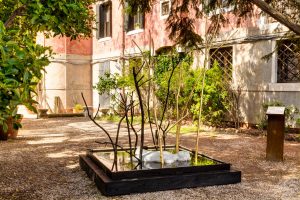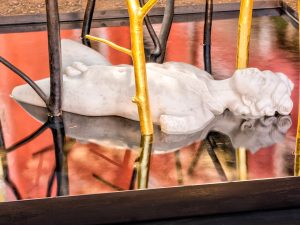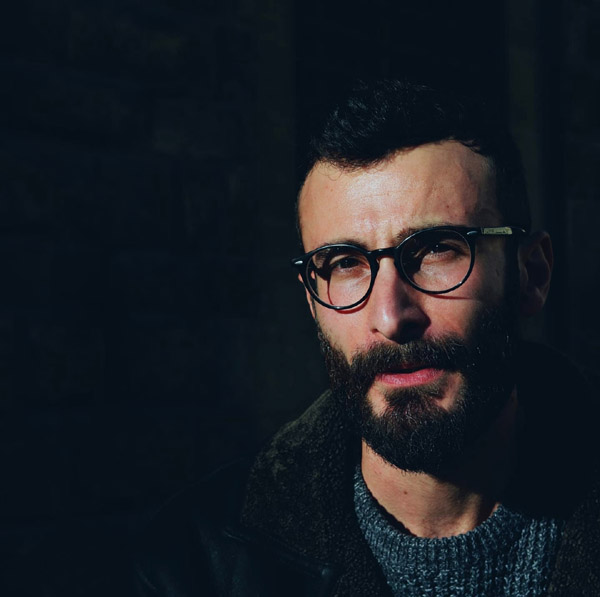One could start from the work exhibited in Postumano Metamorfico (Posthuman Metamorphic) – an exhibition in the San Marino Pavilion set up at Palazzo Donà dalle Rose on the occasion of the 59th Venice Biennale – to try to understand the spirit that moves Michelangelo Galliani’s work. Un Giardino Imperfetto (An Imperfect Garden), 2022, – accompanied by the critical text by Pasquale Lettieri – already contains several elements that characterize his poetics: the marble of a fragmentary statue – identifier material of his practice; the steel of the tank in which this is placed; the water that occupies its surface; the gold leaf applied on the branches that emerge from the small basin; finally – a rather unprecedented solution in the artist’s work – a significant technological component represented by an acoustic device immersed in the tub and a monitor that projects the NFT version of the work.
As in the intentions of the entire exhibition, Un Giardino Imperfetto aims to place man before his own nature, as well as before that which, earlier than his birth, embellishes the planet it shares with him: an essence that is necessarily changing, the result of genetic errors which, on more than one occasion, have not led to unfavorable results, but to profitable and surprising consequences – in fact, the imperfection mentioned in the title would allude to these. Thus, the evolutionary contingencies inherent in the heritage of every living being are added to the effects of modern technologies that try to improve their life, in a dialectical relationship that “would not necessarily determine the end of the world, (as we often hear)” – Galliani himself affirms – but which would lead, perhaps, to the development of “a world different from the one we know”.
Un Giardino Imperfetto, therefore, in the same way as any other work of the artist, constitutes the formalization of the encounter / clash between past and present, between man and nature, between unknown and certainty, in a discourse that, in the specific case of Posthuman Metamorphic, cannot ignore the powerful impact of today’s technological tools. By the way, how to interpret Galliani’s works, if not from the perspective of a repeated synthesis of antithetical and complementary binomials? The marble that constantly oscillates between the completeness of smooth surfaces and the incompleteness of jagged surfaces provides proof of this, as do the blades that often pierce the figures, or the branches – wrapped in gold or silver leaf depending on the case – that sprout from their cavities. The same material combinations underline the powerful contrasts: marble and stainless steel (Vertigo, 2021), wax and lead (Col tempo, 2009), wood and lead (La mia barca, 2009), onyx and stainless steel (Vanitas, 2021). All these materials are appropriately chosen to highlight, from time to time, their anthropic and vegetal, organic and technical, temporary and persistent characteristics.
Furthermore, the poetics of the fragment that has always characterized Galliani’s work arises in the same vein, also an attempt to crystallize in a single time suggestions which are chronologically and ontologically distant from each other: on the one hand, in fact, there is the perennial suspension between the present of the intervention and the archaeological past to which the artist allusively alludes; on the other hand, that which involves the intrinsically incomplete essence of these fragments – unresolved by definition – and the unique and unrepeatable conception of the same, generated by the use of models that have no equivalent, if not in the imagination of the artist himself , subject to the only law of its own mutability.
Thus, respecting the Aristotelian link between form and matter, in Galliani’s work one does not prevail over the other and both are perfect in the same way: in fact, although the aesthetic reference to which he refers appears preponderant at first, this is immediately “disturbed” by the presence of blades and nails, positioned in such a way as to intentionally interrupt the rhythm. Not only that: this fee must also deal with the irregularities of unfinished surfaces, as well as with the interference of materials usually extraneous to it (steel, tin, lead, brass, etc.), which inevitably alter the degree of gentleness and sublimity. On the other hand, the magnificence of marble is essential in the process of approaching the desired contrast, both in visual, tangible and conceptual terms, in terms of thought – not to mention that this has deeply affected the artist’s biographical experience.
If the combination of the different components aims to overcome one’s physical, concrete appearance, in Un Giardino Imperfetto this desire is clearly expressed by the use of NFT technology, but, in any case, Galliani’s works don’t exhaust themselves at the retinal level. Their alchemy induce to reflect on the most contingent issues of our contemporaneity, bringing our gaze to relate with the dimension that concerns us and with the one that most widely surrounds us – a dualism that, in order to materialize, needs our contribution, only apparently reduced to the “simple” act of looking (John Berger teaches).
Antongiulio Vergine
Info:
Michelangelo Galliani. Un Giardino Imperfetto
Postumano Metamorfico, Padiglione di San Marino, 59a Biennale di Venezia
www.michelangelogalliani.net
www.biennaleveneziasanmarino.com
www.cricontinicontemporary.com
![]() Michelangelo Galliani, Vertigo, 2021, black marquinia marble and stainless steel, ph. Enrico Turillazzi, Courtesy Criscontinicontemporary, London, (UK), Porto Montenegro, (MNE)
Michelangelo Galliani, Vertigo, 2021, black marquinia marble and stainless steel, ph. Enrico Turillazzi, Courtesy Criscontinicontemporary, London, (UK), Porto Montenegro, (MNE)
![]() Michelangelo Galliani, Life, 2020, white Carrara marble and lead, ph. Enrico Turillazzi, Courtesy Criscontinicontemporary, London, (UK), Porto Montenegro, (MNE)
Michelangelo Galliani, Life, 2020, white Carrara marble and lead, ph. Enrico Turillazzi, Courtesy Criscontinicontemporary, London, (UK), Porto Montenegro, (MNE)
 Michelangelo Galliani, Un Giardino Imperfetto, 2022, white Carrara marble, wood, steel, gold leaf and water, ph. Enrico Turillazzi, Padiglione di San Marino, 59a Biennale di Venezia, courtesy Padiglione di San Marino
Michelangelo Galliani, Un Giardino Imperfetto, 2022, white Carrara marble, wood, steel, gold leaf and water, ph. Enrico Turillazzi, Padiglione di San Marino, 59a Biennale di Venezia, courtesy Padiglione di San Marino
 Michelangelo Galliani, Un Giardino Imperfetto, 2022, white Carrara marble, wood, steel, gold leaf and water, ph. Enrico Turillazzi, Padiglione di San Marino, 59a Biennale di Venezia courtesy Padiglione di San Marino
Michelangelo Galliani, Un Giardino Imperfetto, 2022, white Carrara marble, wood, steel, gold leaf and water, ph. Enrico Turillazzi, Padiglione di San Marino, 59a Biennale di Venezia courtesy Padiglione di San Marino

Born in Campi Salentina (LE). After the three-year degree in Technologies for the Conservation and Restoration of Cultural Heritage at the University of Salento, I attend the Master of Science in Visual Arts at the University of Bologna. I collaborated with Galleria d’Arte Maggiore g.a.m. (Bologna) and with MUMA – Museum of the Ancient Sea in Nardò (LE). I am interested in events concerning contemporary art, in particular those related to video-photographic and performative practices. I write for ATPdiary and Juliet Art Magazine.






NO COMMENT